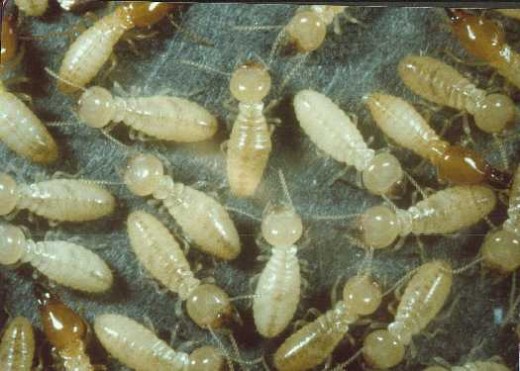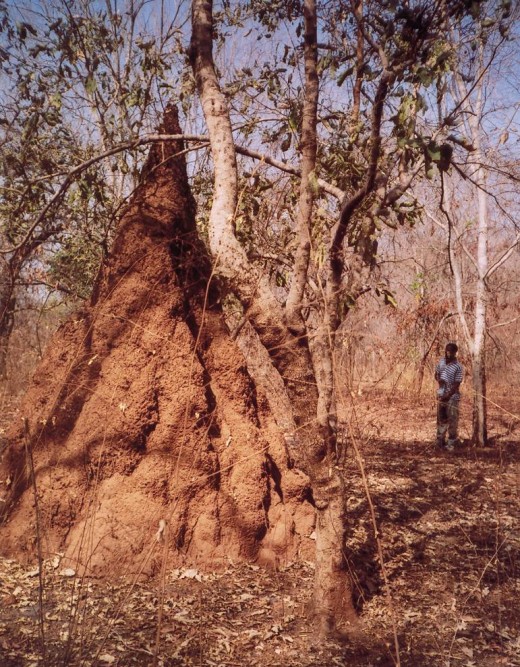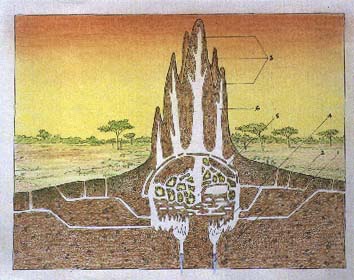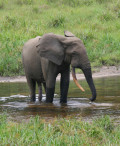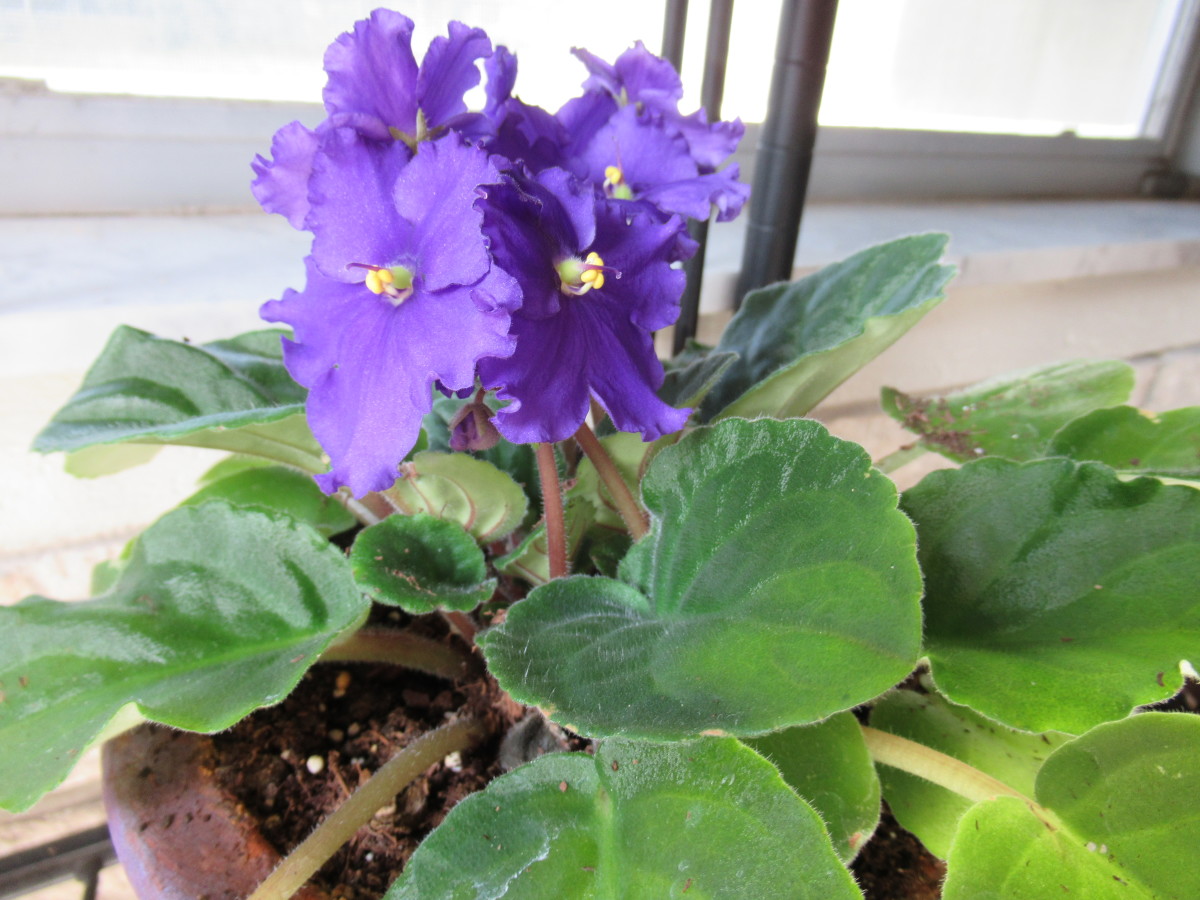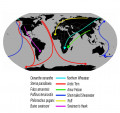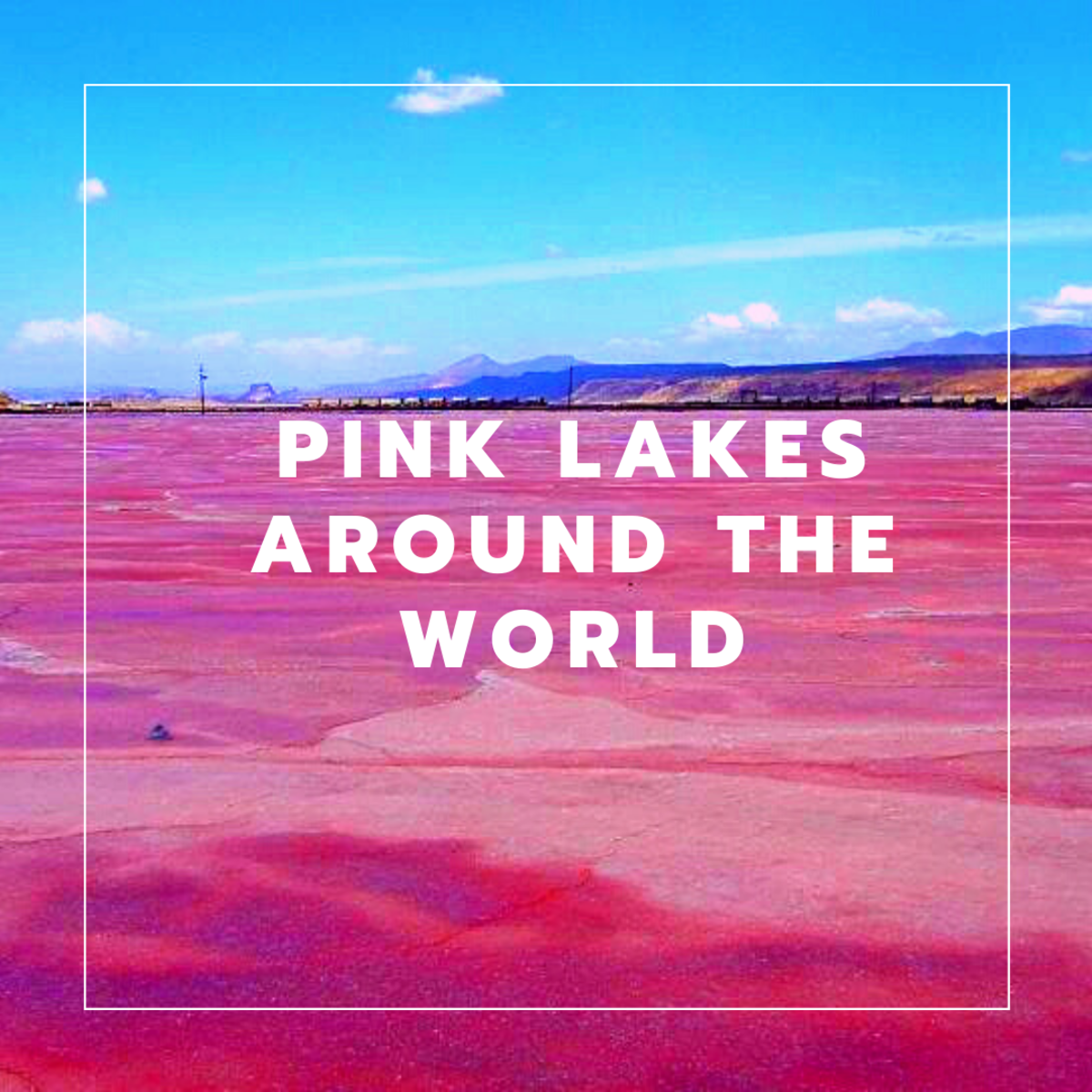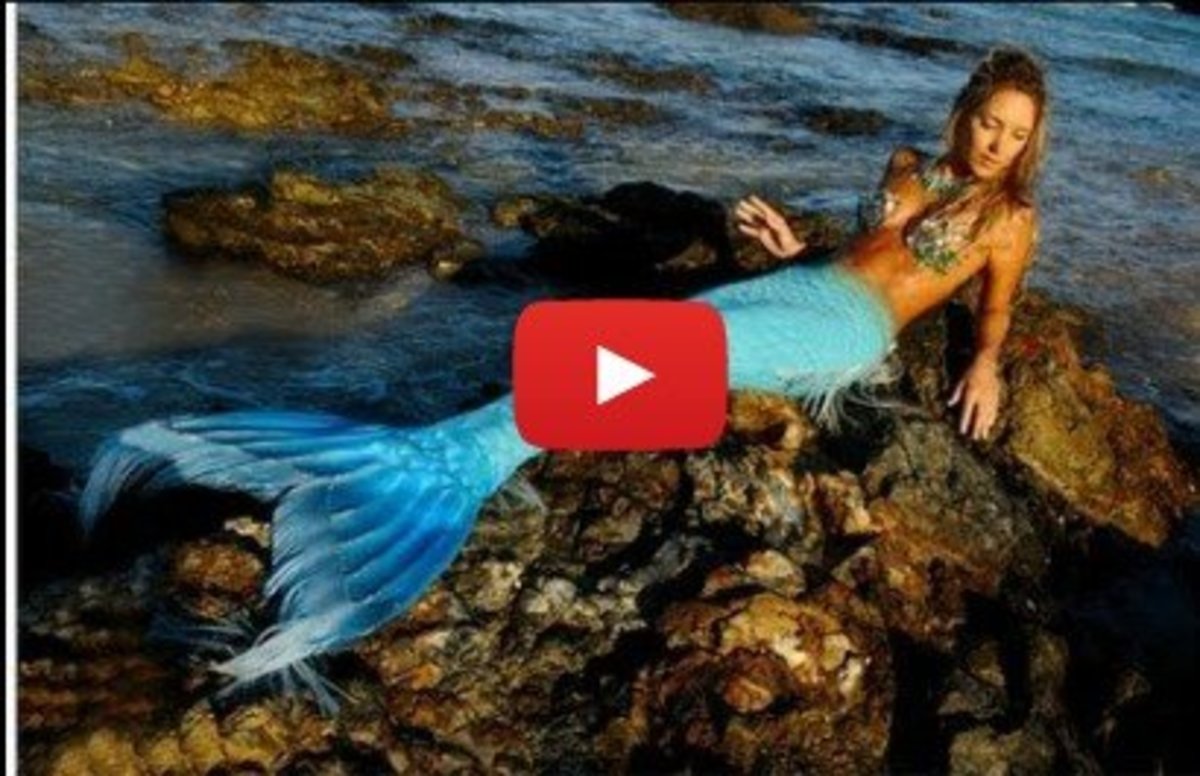African Grasslands
When the wildlife of Africa is mentioned, The first things that comes into everybodys' mind are lions, elephants, cheetahs, rhinoceros, zebras, giraffes, antelopes, and so on. All these animals, in fact, are part of a big and complex biome, the grasslands.
The African grasslands are spreading between the east and west sides of the continent, from Senegal and Guinea to the Indian Ocean. They cover the plains of Sudan, Kenya and the valleys of South Africa.
We don't know much about grasslands (in fact we know very little about them), but we know that they are big, wide planes covered mainly by grass, with some trees here and there and some herbaceous, or perennial flowering plants. Some trees are the baobabs, the euphorbias, or spurges, and acacia trees. The trees usually have small leaves, and lots of times, thorny. As mentioned there are hardly any flowering plants on the grasslands. The reason for this is the climate of this biome. Grasslands have two main periods following each other; there is a period where lots of rain falls. After this rainy period or season comes the dry season, whence no rain, or just very little falls for three to eight moths. Since most plants, besides grass, need "constant " rainfall, they would not be able to grow there, so they don't even try. The fact of the dry and muddy soil explanes why most of the organisms there have big bodies, and why a lot of them have hooves of some sort.
Once, long ago, the grasslands had even much greater diversity of animals than they have today. The grasslands of the Pleistocene era were the most spectacular of all times. These African grasslands had other kinds of rhinoceros, mastodons, elephants, grazing, wild horses, native camels and pronghorns. This era was ended by the ice-age. After the ice age was over the African grasslands weren't the same any more, because most of the animals were killed and some even became extinct. The pronghorns and the native camels, for example did not live there any more, and even the once uncountable number of horses became zebras and a few wild donkeys.
Because of the periodical droughts, the key and the most important life form on the grasslands is grass. Grass is almost the only organisms on savannas (grasslands are also called and referred to as savannas), that stayed there all through the ages. Grass is monocotyledon. Monocotyledons are flowering plants with a single cotyledon. A cotyledon is a struture in an embrio of a seed plant that may form a "leaf" after germination and is commonly known as a seed leaf. Monocotydelons usually have narrow leaves with parallel veins and smooth edges, and hollow or soft stems (just like in the case of grass). Their flower parts are arranged in threes. Back in the dinosaurus' times grass already existed, probably, or something very similar to that. In the Cretaceous Era, as far as we know, grass was mainly tall and semiaquatic, and lived either in swamps or in the shades of the forests. Grasses had such a strong influence on evolution of some mammals that its spread, from the changes in fossil bones and teeth of horses, pronghorns and cattle, can be traced even today. The first known grass is from the Lower Miocene layer, and dates back to about 25 million years. Also it was about this time that the typical skeletal structures of horses started to show up. So, much can be told about the past of the grasslands by studying the remains and fossils of animals that once lived on them.
The grass plant's roots are fibrous, so it holds to the dry soil well during the droughts. When the part of it that is above the ground is destroyed in some ways, for instance, if it is grazed by animals, or burnt by fire, or is dried out due to the drought, it rapidly grows back up. Grass grows from the very base of its stems, not from the the tips of their leaves, or their shoots or roots like other plants do, so the destruction of their leaves do not affect the ability of their growth. Also, it is pollinated by the wind, and reproduce asexually, so it do not depend on insects, which do not live very abundantly on the grassland biomes, because of its climate and long, droughts. The defence of grass against the dry weather periods is interesting too. When there is not enough water available for it, than its leaves curl in lengthwise, so that they make little channels and tubes. This helps, because it decreases the surface area exposed to evaporation by a lot, and by helping it to keepitself to stand upright. Another adaption that increases its strength is that walls of its cells have silica deposited on it. This adaption also helps the animals by strengthening their teeth which compensates for the wear away of their teeth.
As I have mentioned silica decreases the damage of the teeth of ungulated, or hoofed, animals, caused by earth and soil which has been picked up due to the biting off of grass leaves close to the ground. Through the ages, this caused the development of strange molar, or chewing, teeth. These teeth have short roots and high crowns. Their roots are also open which enables the teeth for constant growth which also compensates for the wear of the surface of their molars.
Another great adaption to the dry environment is the big body of the animals that inhabit it, and the fewness of the toes. The loss of toes over the ages in both such odd-toed animals as the horses and the rhinoceros, and such even-toed animals as the pronghorns and cattle are necessary in the wide open environment of the grasslands, where running fast is often necessary. In other words, having a bunch of toes promotes fast running and movement which a lot of times promotes the escape of the animal. Both the feet of the one toed horse and the small, hard hooves of gazelles and are excellent for running on a dry and hard ground. There are several reasons for the necessity of fast running. A couple of them are escaping from predators, fires, and at the begining of the dry season, to go and find an abundant source of water and green grass.
There are several factors that serve an animal positively if it is small. The most obvious is that big bodied animals can run much faster and travel much farther than those that have small bodies, due to the size and tallness of their legs. Also, big animals can reach higher, being able to obtain food from where others cannot. They also can use their food and water better. Since they have bigger bellies, their digestive system is able to store away much greater amount of the food they eat than those who are little. Because of these factors animals, and other organisms, are most often big.
Beside drought, and very heavy rains, there is really another factor that breaks out once or twice in a years, thus forming the lanscape and the ecosystem of it greatly. So fires sweeping through the grasslands, or part of them now and then is, no doubt, an important factor. Although many fires have been recorded (there are both natural and human started), and there are many guesses why and how the natural ones start, we do not really know the real reason. When a fire is started and is spreading, there are only two things animals can and will do. They either run fast or hide somewhere in the ground where fire can't reach them. Although many of the animals run, the grasslands, at least, hide their most important parts. These parts is the grass, the wart hogs, the mole rats, the worms and the bacteria. For the grass, fire is not worse than being grazed, being gried out because of the droughts, or being trampled down. Althoug several severe fires can destroy and kill the very base of the root of the grass, one or just a couple of them won't cause them any major injuries. During a fire lots of animals die, but those who have adaptions against it, like having a big body, and being able to run fast, those can survive. So from this we can conclude that besides grass, fires are also factors that shape not just the landscape of the grasslands, but also the animals that live and inhabit it.
So far, I talked about animals and plants only as a one, and complex ecosystem. From now on, animals and plants will be discussed as different, individual organisms. In other words they will be written about in more details. This project will describe the way of life and the physical traits of some of them living on the savannas, grasslands.
Of all the animals, and plants, but mainly animals, on the grasslands some are wide ranged, so it is not their only habitat. Such animals are the elephants too. They are, next to humans, are probably the most versatile animals in the grasslands. Versatile means that they shape or do many important things, that help, or, maybe, even necessary for their environment, in this case the grasslands. Elephants not just eat the leaves of the grass, but also play an important role in maintaining the environment by the powerful slapings of their trunks and tramping down grasses and other vegetations on the ground. The African elephants today, also called Loxodonta, almost directly descended from the much alike, but much bigger and hairier, mammoths which lived before the first ice age, in the Pliocene and Pleistocene eras. They also are, although not very close, but still relatives of the once lived, but today also extinct animals, the mastodons.
There are only a few perissodactyls, or odd-toed ungulate animals that did not go extinct up till now. These are the zebras, they are still widespread and make up a big part of the game herds, or the herbivores that are hunted down by the big cats and other carnivores, and some times by the humans too. Also other perissodactyls are the rhinoceros, and only a little number of wild donkeys in the most dryest, and most up northern part of the African grasslands. There are much less rinoceros, although they are almost as important members of the savanna biomes as the elephants. Black rhinos are sometimes still seen, but the white rhinos which are close to extinction now can, practicly, never be seen.
African Elephant
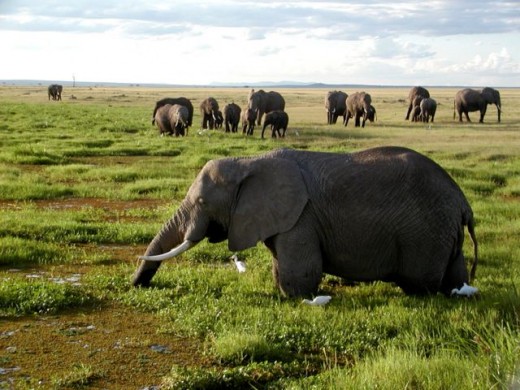
Elephants have relatives even in the same environment as they live in, the grasslands. Although they are relatives of the elephants, they, both ecologically and in size, are closer to rabbits. These animals are the small hyraxes, dassies, or the conies. Hyraxes have small, stout bodies. They have no tails, and have four sort and little toes on their front, and three on their hind feet. There are different kinds of hyraxes, living both on trees and on the ground, among rocks.
Antelopes
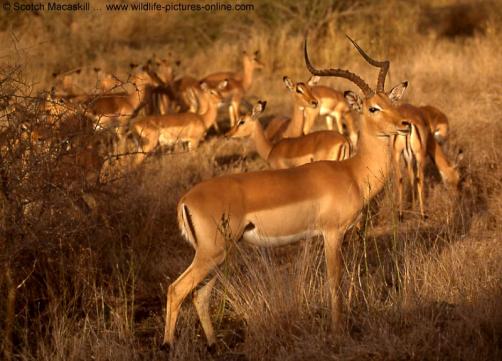
The most populous and diverse group on the grasslands by far are the group of antelopes. Antelopes vary greatly both in size of their bodies, and in the size and shape of their horns. Some antellope horns are straight, some are spiral, and some has rings on them. Some are curved inwards, and some curves outwards. Some are curved backwards, and still others curve many times. Some horns look as if they were only little bumps on the top of the head of the antellope, while others wear big horns. The female horns of some kinds of antellopes are longer than those of males, while other kinds of females don't have horns at all.
Hippo
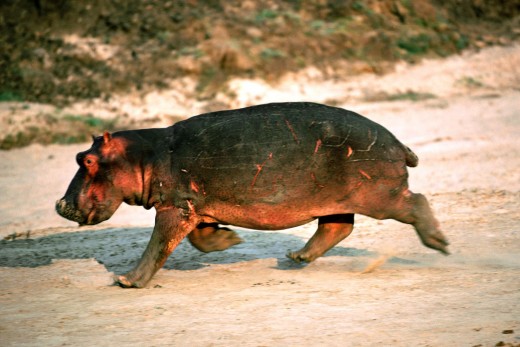
The pig family is also represented in this complex ecosystem. There are the bush pigs and the wart hogs, living in burrows and holes in the ground. Another closely related kind of animal is the hippopotamus, or hippo.
Buffalo
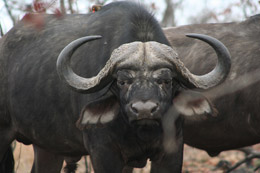
Horses and pronghorns belong to the family that is known as the cattle, or the Bovidae, family today. This is the biggest family of hoofed animals and the most recent mammal family. Bovidae members have cloven hooves, and permanent, branchless horns, worn either by one or both of the sexes. These horns are made from a hollow, and hard material that wraps around the bones that are pretty hard anyway. This family group includes different kinds of buffaloes, cattles, bisons, sheep, goats, and antelopes. The biggest and strongest members are the buffaloes.
Even though grasslands are vast plains, they sometimes are broken by cliffs, hills, and by bodies of waters, like lakes and rivers. This explaines why there are antellopes with some very strange adaptions. For instance, the South African klipspringer has an unusual adaption. Although most kinds of antellopes live in the wide and open, grassy parts of the grasslands, this small species has little, rounded and tiptoed hooves, making it suitable for hopping from one little rock to the other in the cliffy areas, and hills.
Thomson's gazelle
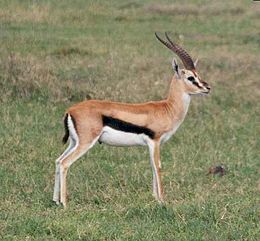
The two most famous species of the antellope family are the gazelles, especially the Thomson's and the Grant's gazelles. They probably are famous because they represent the speed and the beauty of both the movements of gazelles and the beauty of gazelles themselves. Another pretty much known members of this family are the impalas. Although they are a little bigger than most of the gazelles, they still are very athletic. When they suddenly jump, they seem not to put any effort in it. This suggests that they are in total control of their muscles.
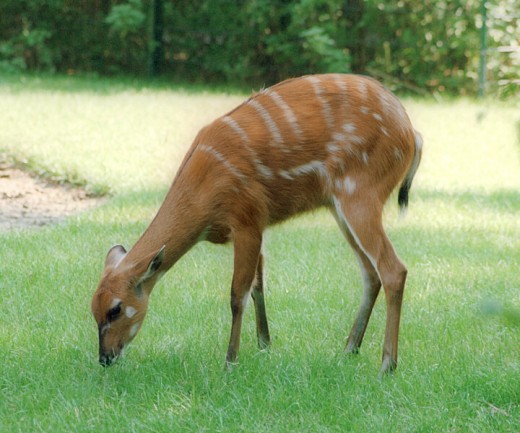
Another strange antellope species is the sitatunga. These antellopes live in water, and even might sleep in it. They have long, horizontal hooves, shaped somewhat like bananas. These kinds of hooves prevent them from sinking in the mud. They also makes them terrible runners.
Another thing that makes the grasslands so fascinating is the season of migrations. Most likely the reason behind migrations on the savannas are the changes in the landscape once in a while. As it has already been mentioned, changes in the landscape are caused by such thing as droughts and fires, but there are other important factors too that causes such drastic changes that the animals have to leave their habitat either just for a while, until conditions for life improve, or for ever. Animals, of course, by migrating do not leave the grassland biomes and the kind of environment, they just move from one section of it to another where they can stay alive. Antellopes, especially the South African springbok, which already have been discussed a bit, are very much known for their vast crowds, and their often catastrophic migrations. Although there is not many left, and so their migrations doesn't cause as much trouble and destruction any more, there are records available for us from the past that describes their catastrophic migrations and the destructions such migrations caused. According to such records, between 1887 and 1896 there were four migrations through the Prieska District of Karoo, Cape Province. A local citizen witnessed them and wrote about them. He said that when the trek reached its peak, nothing, but springboks could be seen for miles. He also wrote that the owners of the Witvlei farm sat round on the top of their wells to keep the springboks away from it, But when the animals saw the well they all ran there and killing and trampling down the masters got to, and in the well. According to this record, thousands were killed in these four particular days (one migration lasted for basiclyone day). Then, in 1888, Mr.Davie, and a naturalist, Dr. Gibbons tried to calculate about how many springbogs participated in these migrations. After a couple millions they gave up.
Springboks are said to be able to migrate about one hundred miles a day. C. S. Stokes once said that not just people were killed, but livestocks too, and that some were even carried along. At the end of their journey, most of the springboks jumped in the sea, killing themselves.
termites
Click thumbnail to view full-size


Next termites and their towers will be discussed, and then the Baobab trees.
Termites, little, antlike creatures,
build the tallest buildings of the animal world. These "skyscrapers" may reach a hight of 6
meters (20
feet). The building material they use are so hard that
sometimes humans will use it to buid their mud houses. This building material
is produced by mixing their saliva and the soil. Termitaries have thick walls
that help air to circulate and to keep the heat out so it is not hot inside. It
also have little pores for the filtering of the air. Every kind of the members
of the colony live in different chambers . A colony may last for close to a
century with changing, always having new members, including the queens and the
kings.
In the termitary four different kinds of termites live. The ones that have the most jobs are called the workers. They build up and repair any damages on their "building". They also take care of the only queen and the only king of the colony. They nourish the eggs too which are produced by the queen and king. The last kind of termites are the soldiers who defend the colony from any attack of any enemy.
Termites dig tunnels that lead to the outside world (that is how they leave the termitary), and tunnels straight down to have water supply.
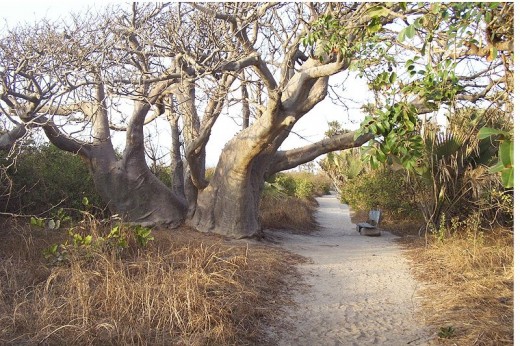
Finally, the last thing that will be
described below is the Baobab, or the monkey tree. Its latin name is Adansonia digitata, and belongs to the
Bombacaceae family. Baobab trees are
native to the African grasslands, but often are cultivated. They are among the
largest trees in the world. Most of the times they grow alone or singly, but
sometimes in small groups, and may be found near villages. The bark of the
baobab tree is smooth and grayish with some purple in it which is
characteristic to this type of tree. Another unusual thing about this tree is
that its leaves often appear after the flowers. The flowers are white and have
purple stamens which is the part of the flower that has the pollen on it. The
monkey tree fruit is somewhat woody, has yellowish hair, and is from 15 to 30 cm (6 to 12 inch) long. It tastes
good.
The dry acid pulp that the fruit contains has many uses just like the other parts of the tree. It is used as an appetizer, seasoning, and for curdling milk. The young leaves are excellent vegetables. The powder of the pulp, the seed, and the leaf can cure such health problems as some kidney troubles, dysentery, fevers, and aches of the ears. The tender roots of the tree are used as fertilizers. Also the the fruits and the seeds are excellent for fertilizers, fuel and soap. The smooth, grey bark produces a strong fiber, useful for packing materials, packing paper, drinking vessels, and musical instruments. Finally the wood, which is soft and can easily be carved, is good for making canoes.
Conclusion
Above were described some of the things that we know about the grasslands of Africa. We know very little about them, but at least we start to realize the need for the preservation of these very complex ecosystems. One of the problems it faces is that its inhibitants lose their habitat, because more and more of the grasslands are turned into farmlands, and more of the organisms get closer and closer to be known as endangered species.

